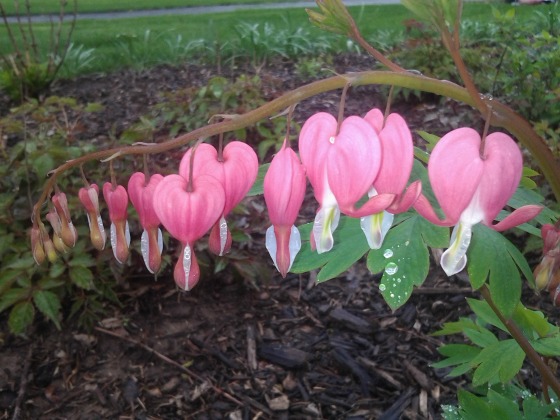
- Bleeding hearts how to#
- Bleeding hearts skin#
- Bleeding hearts full#
Plant shade-loving annuals like begonias or impatiens in the garden space where the bleeding heart grew.Bleeding heart also self-sows prodigiously. Propagate by division in early spring, just before growth starts or by root cuttings in autumn.If transplanting is necessary, do it as soon as the first leaves poke out of the soil in early spring. It will thrive for years without being divided or replanted. Bleeding heart does not like being moved.Leave 1 inch of the stalk to protect the crown during the winter months.
 When the plant goes dormant, you may cut back the leaves and stems when they begin to yellow and wither away. Deadheading faded flowers can prolong bloom of some varieties. But once established, only water if rainfall is less than 1 inch per week. If you plant is new, we would suggest watering weekly during the first season. In spring, apply a thin layer of compost, followed by mulch, to help retain moisture (and deter weeds). Soil rich with organic matter is all the fertilizer this plant needs. Near the house, mix with hostas and lamium for texture. The hearts appear to be dripping (hence its most common name).īlooming in the spring, bleeding heart will grow up to 2 feet high and up to 30 inches wide. It finishes its growing cycle when warm weather sets in. The flowers fade, the leaves die back, and the plant goes dormant in late spring or early summer.īleeding Hearts are woodland plants so they enjoy the partial shade of spring-flowering trees such as dogwoods and serviceberries. Once called the finest hardy plant of the 19th century, bleeding heart soon became as “common as a wallpaper pattern.” Today, this perennial is in favor because it is easy to grow and nothing surpasses its attention-getting form: graceful arching, 3-foot stems adorned with dangling pink, red, or white flower hearts.
When the plant goes dormant, you may cut back the leaves and stems when they begin to yellow and wither away. Deadheading faded flowers can prolong bloom of some varieties. But once established, only water if rainfall is less than 1 inch per week. If you plant is new, we would suggest watering weekly during the first season. In spring, apply a thin layer of compost, followed by mulch, to help retain moisture (and deter weeds). Soil rich with organic matter is all the fertilizer this plant needs. Near the house, mix with hostas and lamium for texture. The hearts appear to be dripping (hence its most common name).īlooming in the spring, bleeding heart will grow up to 2 feet high and up to 30 inches wide. It finishes its growing cycle when warm weather sets in. The flowers fade, the leaves die back, and the plant goes dormant in late spring or early summer.īleeding Hearts are woodland plants so they enjoy the partial shade of spring-flowering trees such as dogwoods and serviceberries. Once called the finest hardy plant of the 19th century, bleeding heart soon became as “common as a wallpaper pattern.” Today, this perennial is in favor because it is easy to grow and nothing surpasses its attention-getting form: graceful arching, 3-foot stems adorned with dangling pink, red, or white flower hearts. Bleeding hearts how to#
Learn when to plant bleeding heart, how to care for it, and other tips in our growing guide. This hardy plant blooms prolifically in early spring and finishes its growing cycle when warm weather sets in. Alkaloids negatively affect animals, most commonly cattle, sheep, and dogs.The old-fashioned “bleeding heart” flower has long been a favorite perennial of the shady flower garden. Although aesthetically pleasing, this plant contains soquinoline alkaloids. Wear gloves and other protective equipment when handling. Bleeding Heart plants are not only toxic to humans but to animals as well.
Bleeding hearts skin#
If ingested, all parts may cause stomach upset, the foliage may aggravate skin allergies.  Propagate by division in early spring or after the leaves have died down. Great for beds and borders, cottage gardens, rock gardens, containers, underplanting shrubs, or as a ground cover. Do not plant in heavy clay soils as it does not do well in wet.
Propagate by division in early spring or after the leaves have died down. Great for beds and borders, cottage gardens, rock gardens, containers, underplanting shrubs, or as a ground cover. Do not plant in heavy clay soils as it does not do well in wet. Bleeding hearts full#
It can be grown in full sun provided the soil is kept consistently moist.
Thrives in part shade and is easily grown in fertile, humus-rich, preferably neutral or slightly alkaline, moist, but well-drained soils. Give it more sun than you would typically give a bleeding heart flower, and you will be rewarded with stronger growth and more blooms. Unlike other bleeding hearts, this alpine-type bleeding heart is not a woodland plant. The blossoms attract bees and hummingbirds. Blooming over a long season extending from late spring to fall, the pale and dark pink heart-shaped flowers, adorned with an elegant curl at the tips, dangle gracefully above the foliage mound, which remains fresh-looking throughout the growing season. Dicentra 'Pink Diamonds' (Fern-Leaf Bleeding Heart) is a compact perennial noted for its beautiful fern-like blue-green foliage and its profusion of two-tone pink flowers.






 0 kommentar(er)
0 kommentar(er)
